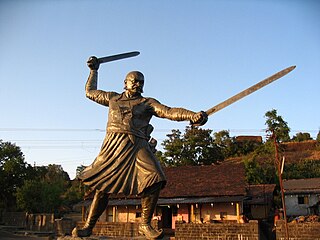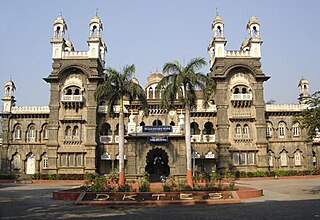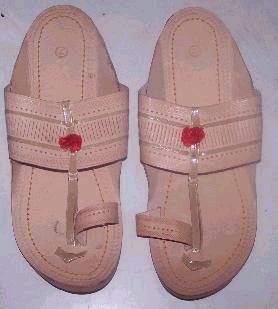Related Research Articles

Weaving is a method of textile production in which two distinct sets of yarns or threads are interlaced at right angles to form a fabric or cloth. Other methods are knitting, crocheting, felting, and braiding or plaiting. The longitudinal threads are called the warp and the lateral threads are the weft, woof, or filling. The method in which these threads are interwoven affects the characteristics of the cloth. Cloth is usually woven on a loom, a device that holds the warp threads in place while filling threads are woven through them. A fabric band that meets this definition of cloth can also be made using other methods, including tablet weaving, back strap loom, or other techniques that can be done without looms.

Solapur is a city located in the south-western region of the Indian state of Maharashtra, close to its border with Karnataka. Solapur is located on major highway, rail routes between Mumbai, Pune, Bangalore and Hyderabad, with a branch line to the cities of Kalaburagi and Vijayapura in the neighbouring state of Karnataka. Solapur International Airport is under construction. It is classified as A1 Tier and B-1 class city by House Rent Allowance (HRA) classification by the Government of India. It is the seventh biggest Metropolis Urban Agglomeration and 11th most populated city in Maharashtra as well as 43rd largest urban agglomeration and 49th most populous city in India.

Sushilkumar Sambhaji Shinde is an Indian politician from the state of Maharashtra. He was the Minister of Home Affairs, Minister of Power in the Manmohan Singh government, and the Leader of the House in Lok Sabha until 26 May 2014. He previously served as the Chief Minister of Maharashtra from 18 January 2003 to 4 November 2004.

Jamdani is a fine muslin textile produced for centuries in South Rupshi of Narayanganj district in Bangladesh on the bank of Shitalakhwa river.

Kolhapur district is a district in the Maharashtra state of India. The city of Kolhapur is its district headquarter. It is situated near Panchaganga river.

A Banarasi sari is a sari made in Varanasi, an ancient city which is also called Benares (Banaras). The saris are among the finest saris in India and are known for their gold and silver brocade or zari, fine silk and opulent embroidery. The saris are made of finely woven silk and are decorated with intricate designs, and, because of these engravings, are relatively heavy.

Ichalkaranji ([it͡səlkəɾəɳd͡ʒiː]) situated at the bank of the Panchganga River, is a city in Kolhapur District, Indian state of Maharashtra, governed by a municipal corporation. It is known for its textile manufacturing industry and "Manchester City of Maharashtra".

Navajo weaving are textiles produced by Navajo people, who are based near the Four Corners area of the United States. Navajo textiles are highly regarded and have been sought after as trade items for more than 150 years. Commercial production of handwoven blankets and rugs has been an important element of the Navajo economy. As one art historian wrote, "Classic Navajo serapes at their finest equal the delicacy and sophistication of any pre-mechanical loom-woven textile in the world."
Assam silk denotes the three major types of indigenous wild silks produced in Assam—golden muga, white pat and warm eri silk. The Assam silk industry, now centered in Sualkuchi, is a labor-intensive industry.

A weavers' cottage was a type of house used by weavers for cloth production in the putting-out system sometimes known as the domestic system.

Kolhapuri chappals are Indian decorative hand-crafted and braided leather slippers that are locally tanned using vegetable dyes. Kolhapuri Chappals or Kolhapuris as they are commonly referred to are a style of open-toed, T-strap sandal, but also braided leather Mules or braided leather shoe type designs are also common.

Siripuram is a village and a gram panchayat of Ramannapet Mandal, Nalgonda District, in Telangana state in India.. It is 71km from Hyderabad.
The textile industry in India traditionally, after agriculture, is the only industry that has generated huge employment for both skilled and unskilled labour. The textile industry continues to be the second-largest employment generating sector in India. It offers direct employment to over 35 million people in the country. India is the world's second largest exporter of textiles and clothing, and in the fiscal year 2022, the exports stood at US$ 44.4 billion. According to the Ministry of Textiles, the share of textiles in total exports during April–July 2010 was 11.04%. During 2009–2010, the Indian textile industry was pegged at US$55 billion, 64% of which services domestic demand. In 2010, there were 2,500 textile weaving factories and 4,135 textile finishing factories in all of India. According to AT Kearney’s ‘Retail Apparel Index’, India was ranked as the fourth most promising market for apparel retailers in 2009.

Silk weaving is a manufacturing industry in Varanasi. Varanasi is known throughout India for its production of very fine silk and Banarasi saris.
Venkatagiri Sari is a sari style woven in Venkatagiri of Tirupati district in the Indian state of Andhra Pradesh. It was registered as one of the geographical indication from Andhra Pradesh by Geographical Indications of Goods Act, 1999. Venkatagiri saris are known for their fine weaving. These style of saris can also be found in the villages of Sengunthapuram, Variyankaval, Elaiyur, Kallathur, Andimadam and Marudhur villages.
Kovai Cora cotton or Kovai Kora cotton is a type of saree made in the Coimbatore region in Tamil Nadu, India. It has been recognized as a Geographical indication by the Government of India in 2014–15. The Devanga community are pioneers in weaving Kovai Kora cotton saris. 82 Weaver cooperative Societies in Coimbatore, Tiruppur and Erode are authorised to sell Kovai Kora cotton saris.

Bhavani Jamakkalam refers to blankets and carpets manufactured in Bhavani in Erode district, Tamil Nadu. It has been recognized as a Geographical indication by the Government of India in 2005-06.
Navalgund durries, geographically tagged in India, are woven durries or a type of Indian rug with geometric designs, birds, and animal designs from Navalgund in Dharwad district of Karnataka, India

Solapur Terry Towel is terry towel weaving or knitting work that are manufactured in the Solapur district of Maharashtra state, India. The terry towel work has been protected under the Geographical indication (GI) of the Agreement on Trade-Related Aspects of Intellectual Property Rights (TRIPS) agreement. It is listed at item 9 as "Solapur Terry Towel" of the GI Act 1999 of the Government of India with registration confirmed by the Controller General of Patents Designs and Trademarks.
Suraiya Hasan Bose was an Indian textile conservator, textile designer, and manufacturer, who worked to preserve traditional Indian textile art and techniques. She worked with the Indian Cottage Industries Emporium, as well as the Indian Handloom and Handicrafts Export Corporation, later establishing her own textile manufacturing unit to create traditional Indian textiles. Her designs have been exhibited in the Victoria and Albert Museum.
References
- 1 2 Srivastava, Roli (12 October 2014). "Shindes losing ground like chaddar in Solapur". The Times of India. Retrieved 6 July 2015.
- 1 2 3 "Cottage Industry in Solapur". Official Website of Solapur District. Archived from the original on 9 July 2015. Retrieved 6 July 2015.
- ↑ Gurubal Mali (25 June 2015). "Kolhapuri Masalyala 'GI' chi Phodani" कोल्हापुरी मसाल्याला 'GI' ची फोडणी [Sprinkle 'GI' on Kolhapuri Spice]. Maharashtra Times (in Marathi). Kolhapur. Archived from the original on 7 July 2015. Retrieved 6 July 2015.
- 1 2 अभय दिवाणजी (19 January 2013). सोलापूरची उबदार ओळख [The warm introduction of Solapur]. Saptahik Sakal (in Marathi). Archived from the original on 7 July 2015. Retrieved 6 July 2015.
- ↑ "Welcome to Pulgam Textiles, Solapur". Pulgam textiles. Archived from the original on 23 January 2016. Retrieved 13 February 2016.